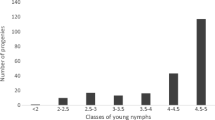Abstract
Oviposition by the potato leafhopperEmpoasca fabae was measured on detached leaflets from nine half-sib groups (18 full-sib families) of tetraploid potatoes. The parents were clones that had been used in the USDA breeding program.
Significant differences occurred among full-sib families, and between full-sib families with a common parent, but not among half-sib groups. The variance component for between full-sib families with a common parent averaged over twice as large as the component due to differences among half-sib groups. Although this could be due to intra-locus interaction, it seemed that common environmental effects were a more likely cause.
Previous feeding on beans affected leafhopper oviposition in the first 4-day test period. By the 2nd test period the effect had disappeared, and results in test periods 2, 3, and 4 were consistent with each other. With a procedure including a feeding period on potatoes before testing, phenotypic selection of individuals was shown to be more efficient than selection by progeny testing with half or full-sib families for increasing resistance to oviposition.
The ranking of families by the amount of oviposition on detached leaflets and by nymph infestation densities in the field were similar at the extremes of the resistance range, but variable in between.
Similar content being viewed by others
Literature Cited
Carlson, O. V., and E. T. Hibbs. 1962. Direct counts of potato leafhopper,Empoasca fabac, eggs inSolanum leaves. Ann. Entomol. Soc. Amer. 55: 512–515.
O'Keeffe, L. E. 1965. The influence of environmental factors upon oviposition ofEmpoasca fabae (Harris) (Cicadellidae, Homoptera). Unpublished Ph.D. dissertation. Microfilm No. 66-3892, Iowa State University of Science and Technology, Ames, Iowa.
Comstock, R. E., and H. F. Robinson. 1948. The components of genetic variance in populations of biparental progenies and their use in estimating the average degree of dominance. Biometrics 4: 254–266.
Kempthorne, O. 1955. The correlation between relatives in a simple autotetraploid population. Genetics 40: 168–174.
Sanford, L. L., and J. P. Sleesman. 1970. Genetic variation in a population of tetraploid potatoes: Response to the potato leafhopper and the potato flea beetle. Amer. Potato J. 47: 19–34.
Author information
Authors and Affiliations
Additional information
Journal Paper No. J-6653 of the Iowa Agriculture and Home Economics Experiment Station, Ames, Iowa. Project No. 1623. This study was supported in part by Research Grant G-10923, from the National Science Foundation and in part by Basic Research Grant 12-14-100-8025(34) from the U. S. Department of Agriculture, Agricultural Research Service.
Rights and permissions
About this article
Cite this article
Sanford, L.L., Carlson, O.V. & Hibbs, E.T. Genetic variation in a population of tetraploid potatoes: Foliar resistance to oviposition of the potato leafhopper. American Potato Journal 49, 98–108 (1972). https://doi.org/10.1007/BF02868223
Accepted:
Issue Date:
DOI: https://doi.org/10.1007/BF02868223




